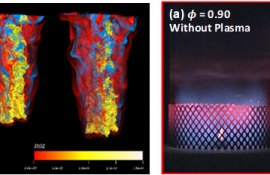- * 프린트는 Chrome에 최적화 되어있습니다. print

In Clean Combustion & Energy Research lab, we are investigating the characteristics of laminar/turbulent reacting flows using direct numerical simulations (DNS), large eddy simulations (LES), and Reynolds-Averaged Navier-Stokes Simulations (RANS) to understand flame instability, turbulence/chemistry interaction, etc. An indepth understanding of fundamental characteristics of laminar/turbulent flames can help us develop next-generation IC engines, gas turbines (GT), and commercial boilers. We are also interested in hydrogen/ammonia/supercritical/plasma combustion to develop low carbon/high-efficient IC engines and GT combustors. Hydrogen and ammonia are carbon-free energy source such that they are now being applied to conventional GT combustors. Recently, a supercritical GT combustion emerges as a next-generation technology for power generation, and hence, we are investigating the characteristics of supercritical combustion at 250 bar or above. To reduce NOx emission, fuel-lean combustion is inevitable, which ultimately induces flame instabilities in the combustor. To control such flame instabilities, plasma-assisted combustion is also actively investigated. In addition, we are developing a CFD code for hydrogen production through ammonia cracking considering both gas-phase chemistry and surface chemistry.
Major research field
DNS/LES/RANS, Gas Turbine Combustion, Plasma-assisted Combustion, sCO2 Oxy-fuel Combustion, Ammonia Cracking & Combustion
Desired field of research
Solid Rocket Propulsion, LH2/LOX Rocket Propulsion
Research Keywords and Topics
Turbulent Combustion, Direct Numerical Simulation, Engine Combustion, Gas Turbine Combustion, Plasma-assisted Combustion, sCO2 Oxy-fuel Combustion, Ammonia Reforming/Cracking & Combustion
Research Publications
MORE· Computer Physics and Communication 273, 108264, "Real-fluid thermophysicalModels library: An OpenFOAM-based library for reacting flow simulations at high pressure", Nguyen, D.N., Jung, K.S., Shim, J.W., Yoo, C.S., 2022,
· Combustion and Flame 233, 111584, "On the stabilization mechanisms of turbulent lifted hydrogen jet flames in heated coflows near the auto-ignition limit: A comparative DNS study", Jung, K.S., Kim, S.O., Lu, T., Chen, J.H., Yoo, C.S., 2021
· Combustion and Flame, 212, 403-414, "Effects of non-thermal plasma on the lean blowout limits and CO/NOx emissions in swirl-stabilized turbulent lean-premixed flames of methane/air", Kim, G.T., Yoo, C.S., Chung, S.H., J., 2020.
Patents
· [국내] 예혼합 압축 착화 엔진의 연소 제어 방법, 유춘상, (2012.03)
국가과학기술표준분류
- EA. 기계
- EA09. 자동차·철도차량
- EA0901. 엔진/동력전달장치
국가기술지도분류
- 환경/에너지 프론티어 진흥
- 031100. 수소에너지기술
녹색기술분류
- 고효율화기술
- 수송효율성 향상
- 331. 고효율 저공해차량기술
6T분류
- ST 분야
- 발사체기술
- 040214. 기타 발사체기술




